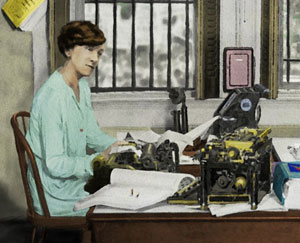BITE-SIZED HISTORY
Published in Issue 3 (May/June 2019), News, Volume 27BY TONY CANAVAN
Did Vikings bring leprosy to Ireland?
In years past, little was known about how leprosy came to medieval Ireland, but thanks to research done by Queen’s University, Belfast, the University of Surrey and the University of Southampton we may now have an answer: Vikings. The study focused on five cases of probable leprosy that were identified in human skeletal remains excavated from burials in Ireland. Three of the individuals were from a cemetery in Dublin, one from County Kildare and one from County Antrim. The Dublin remains were revealed to have two different strains of leprosy, originating from Scandinavia (Type 3) and the Middle East (Type 2). None of the individuals appeared to have been born in the Dublin area; one may have been from the north of Ireland or Britain, while the other two were most likely from parts of Scandinavia—potentially linking leprosy to the Vikings. Researchers hope that their discovery will encourage further research into the historical spread of the disease.
Belfast brought to a standstill
This year marks the 100th anniversary of the biggest industrial strike in Belfast history: the 1919 engineering strike. The four-week-long walk-out involved 40,000 shipyard and other engineering workers—both Catholics and Protestants—who were demanding a reduction from their 54 hours to a 44-hour working week in a plea for better working conditions. The strikers came from larger companies like Harland and Wolff, the smaller shipyard of Workman Clark and engineering plants such as Mackie’s and Sirocco. These workers brought the whole city to a standstill, shutting down trams, shops and most printing presses owing to the lack of electricity being generated. While they did not immediately obtain their original demand of a 44-hour week, their determined actions paved the way for the current 39-hour working week.
The wrong kind of unionist?

Above: Winifred Carney (1887–1943)—trade unionist, suffragist and republican female. The erection of a permanent statue in Belfast is up for further discussion. (Declan Kerr)
Belfast will soon be seeing six new statues erected, but so far one statue is causing a lot of debate. In reaction to the Equality Impact Assessment in 2012 that highlighted the lack of female and nationalist statues in the city, these six statues were to represent the underrepresented and be a gesture of equality among parties and people. However, Sinn Féin councillors weren’t happy that the statue of Winifred Carney (1887–1943)—a trade unionist, suffragist and republican female—would only be hosted temporarily in the city before being retired. Sinn Féin council leader Ciaran Beattie said that making the statue a permanent fixture would be a step in the right direction towards balancing the scales of representation, calling the current state of the statues in the city a ‘gross imbalance’. The debate over Winifred Carney’s statue is now in the hands of a committee for further discussion.
1,500th anniversary of the birth of St Colmcille
Local authorities in Derry and Donegal are making plans to mark the 1,500th anniversary of the birth of St Colmcille, the patron saint of Derry, which occurs next year. A ‘Columban Heritage audit’, a catalogue of mapped heritage sites, objects and archives associated with the saint, was conducted earlier this year. It is hoped that this will provide the basis for a programme of events celebrating the saint’s life and legacy. The public is being given the chance to highlight existing and proposed initiatives designed to promote the Columban heritage. Born into a royal family near Gartan, Co. Donegal, around 520/21, Colmcille (a.k.a. St Columba) founded a monastic settlement that over the centuries became the city of Derry. The saint is closely associated with Derry and Donegal, as evidenced by the many landmarks, churches and schools that bear his name. Following a quarrel with St Finnian, Colmcille was banished from Ireland. He settled in Iona off the west coast of Scotland, where he established the monastery that still exists today. Colmcille is credited with many miracles, the most famous of which was when he banished a monster to the depths of Loch Ness after it killed a man—the origin of the legend of the Loch Ness Monster.
The Mary Elmes Prize in Holocaust Studies
The Holocaust Education Trust Ireland, in association with the History Teachers Association of Ireland, is launching the Mary Elmes Prize in Holocaust Studies for Transition Year students in September 2019. The prize is named in honour of Mary Elmes, an Irishwoman who saved scores of children during the Holocaust. In 2013 Mary was (posthumously) named Righteous Among the Nations by Yad Vashem, the Holocaust Remembrance Authority in Israel. She is the first Irish person to be so honoured. Students are invited to complete a project or a piece of work to raise awareness about the Holocaust, inspired by Mary Elmes and her story. Students can pick one option from one of the following categories: literary response, musical response or artistic response. Candidates should become familiar with the history of the Holocaust and a reading list is available on the website. A virtual ‘Tree of Life’ dedicated to Mary Elmes will be created on-line. As the winner of each section is announced, a leaf will be inscribed on the tree in their name. The tree will grow, and the number of leaves will increase each year. Each winning student will receive a certificate, a replica of their leaf inscribed with their name and date, and a lapel pin to wear. The submission date is 10 December 2019. For full details, see hetireland.org/programmes/mary-elmes-prize/.
















